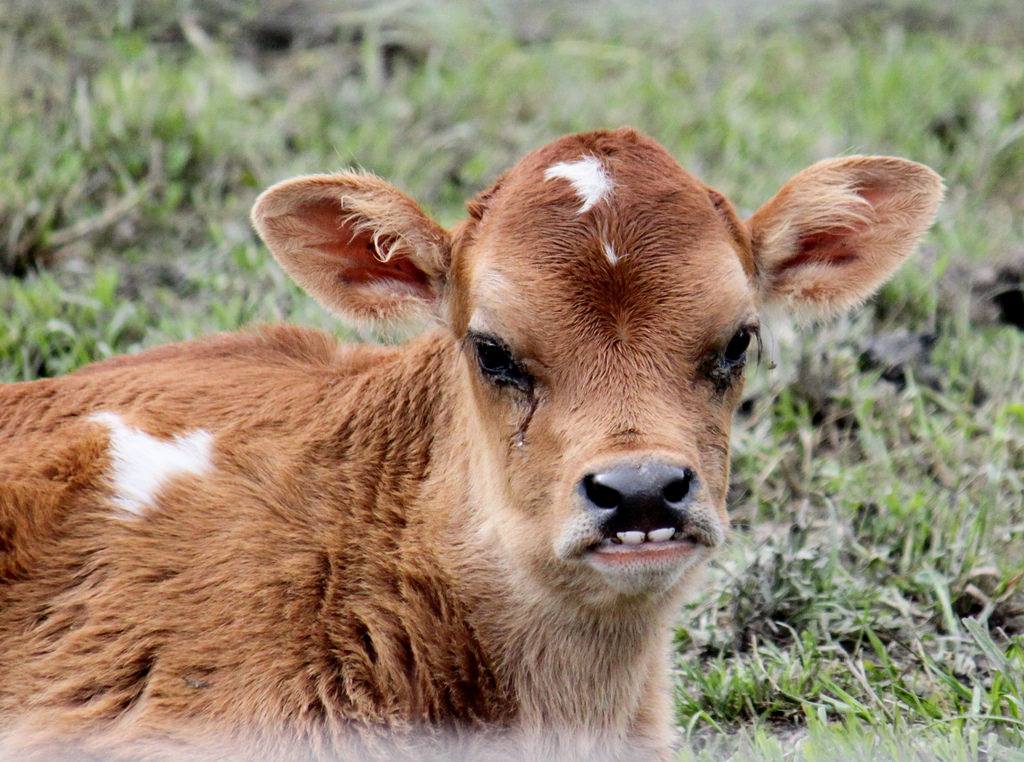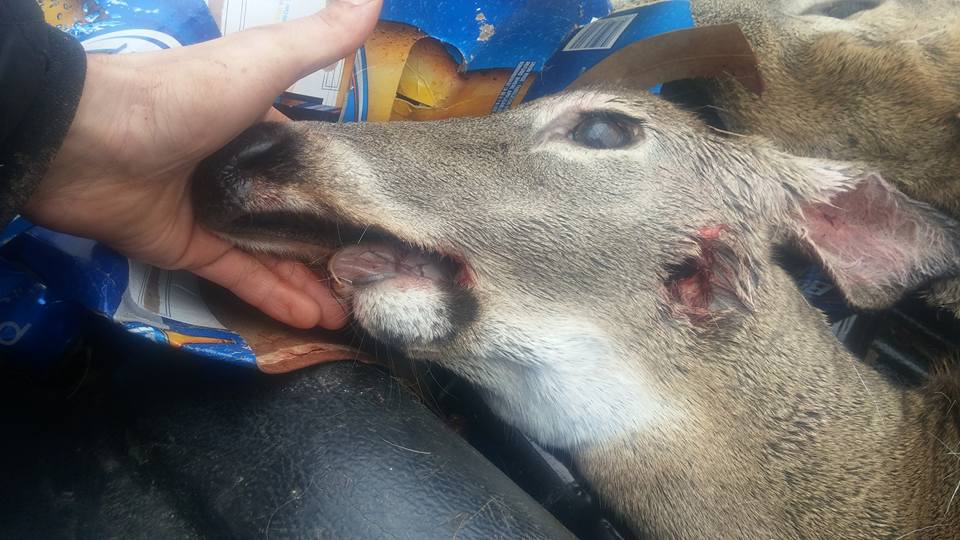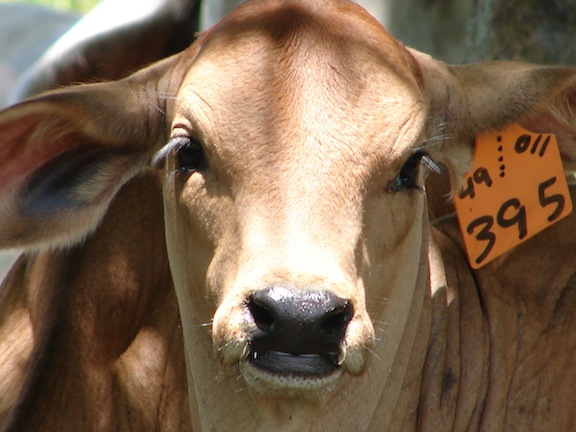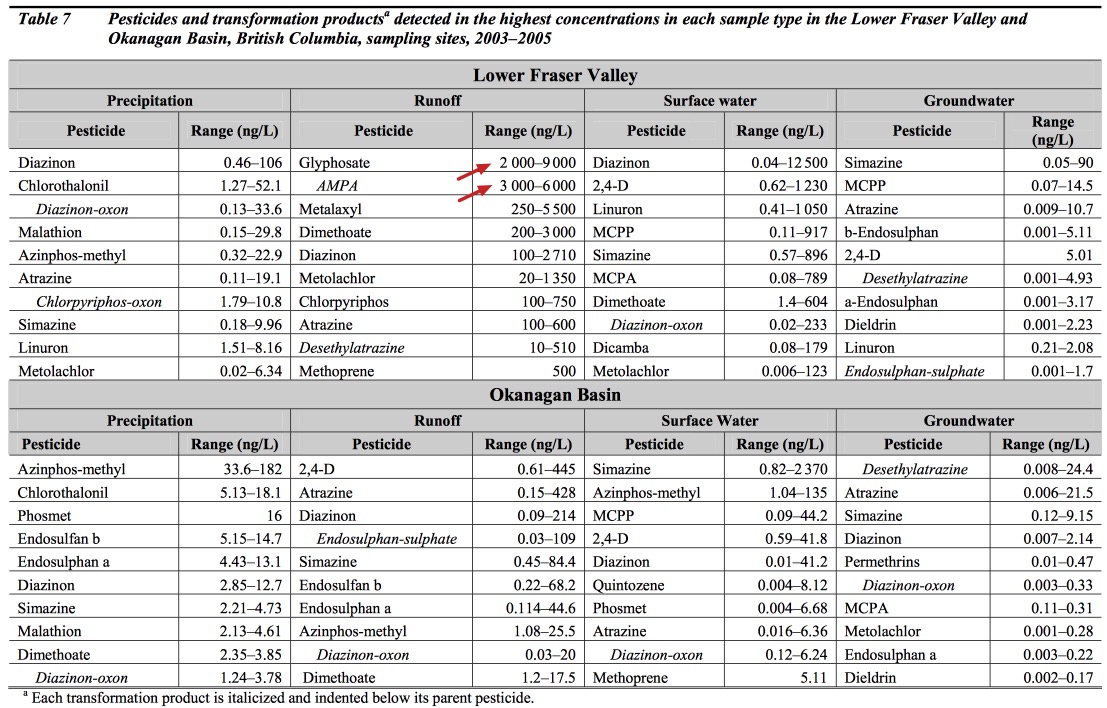
Prominent underbite in a calf
There is an unending series of bad news and devastation across the landscape, triggered by suspected harmful effects of man made toxins in our midst. This blog is to do with glyphosate in the food and feed of domestic cattle. The material for this blog is provided by Montana used wildlife scientist Judy Hoy.
I had received a lot of information over the years from Judy. She is listed as one of the four scientists I have most learned from regarding the ravages causes globally by glyphosate. Her name and picture, along with those of Anthony Samsel, Stephanie Seneff and Don Huber, occupy one slide of my presentation on glyphosate when I am asked to speak, in India.

Deer from New Brunswick, Canada
I had contacted her when folks from New Brunswick, Canada, contacted me asking about the weird phenomenon being noticed among hunted deer, which showed mismatched jaws. She confirmed this is merely an extreme case of a common birth defect where a fetus in a mothers womb is poisoned by specific toxins such as glyphosate. The reason for this damage is complex, but has to do with disruption of some of the growth programs in the fetus, due to damage to hormones, enzymes and other proteins that are critical, and also from severe deficiency of specific mineral nutrients during that phase of foetal development. Both these conditions will happen if glyphosate is in the food and foliage that the pregnant mother forages and eats. Glyphosate will get itself mis-incorporated into proteins by being an analog of glycine. Glyphosate will also steal minerals from food by being a chelator.
There has been a lot of feedback from Judy over the years about degeneration in North American wildlife and the very real possibility that its very survivability is now questioned. Wildlife in North America, in other words, faces a serious existential threat and likely will go under due to birth defects not just in jaws but in many organs including reproductive organs. Percentage of bison, and all kinds of deer wild goats and sheep, as well as other carnivores and herbivores, that have visible birth defects including malformed reproductive organs, as observed by naked eyes and available from photographs and video, are approaching 100%. Many of them will not be producing viable off springs to propagate survival of the species. We have brought nature and wildlife to the brink through man made toxins.
But what about domestic cattle?
I wondered what was happening to domestic cattle, which should be far more affected by glyphosate through greater human contribution in their food and feed. Well, here is what Judy had to say about it, along with a few pictures of calves from Mexico.
Hi Tony,
 Cattle in the United States, Mexico and of course Canada are born with an underbite, just like the wild grazing animals. Here in our area, some of the larger ranchers were loosing up 30 or 35 calves each spring in the late 1990s, through 2001. I put letters to the editor in our local papers saying that the symptoms on the calves were consistent with thyroid hormone disruption as a result of mineral deficiencies. I also told local veterinarians. I suddenly stopped hearing about birth defects on calves here in our area and called a rancher friend to ask him if the ranchers were doing something different. He said they were having their cows tested to determine what minerals they were deficient in and then giving their herd the specific minerals they needed. That apparently mitigated the birth defects significantly, suggesting that chelation of the minerals the livestock obtained in grass and hay by exposure to the Roundup on the grass or hay was the likely culprit. As far as I know, their grass and hay was never tested for glyphosate, because the ranchers wouldn’t believe that Roundup was responsible. Many spray their Roundup Ready alfalfa fields and didn’t want to admit that they were poisoning their own animals. Funny how that works.
Cattle in the United States, Mexico and of course Canada are born with an underbite, just like the wild grazing animals. Here in our area, some of the larger ranchers were loosing up 30 or 35 calves each spring in the late 1990s, through 2001. I put letters to the editor in our local papers saying that the symptoms on the calves were consistent with thyroid hormone disruption as a result of mineral deficiencies. I also told local veterinarians. I suddenly stopped hearing about birth defects on calves here in our area and called a rancher friend to ask him if the ranchers were doing something different. He said they were having their cows tested to determine what minerals they were deficient in and then giving their herd the specific minerals they needed. That apparently mitigated the birth defects significantly, suggesting that chelation of the minerals the livestock obtained in grass and hay by exposure to the Roundup on the grass or hay was the likely culprit. As far as I know, their grass and hay was never tested for glyphosate, because the ranchers wouldn’t believe that Roundup was responsible. Many spray their Roundup Ready alfalfa fields and didn’t want to admit that they were poisoning their own animals. Funny how that works.

Mexican Brahman calf with underbite
Most of the ranchers here in our area that I asked never actually admitted that their calves had a high rate of underbite, except for one rancher’s wife, who told me in 2003 that about 1/3 of their calves were born with underbite. In addition to calves, domestic goats, sheep and camelids here in the United States are also born with underbite. I was told that in 2001, over 50 horse foals born that spring in our county were shot because they were born with an underbite. Livestock owners don’t want anyone to know that their livestock have birth defects. They will kill a newborn rather than admit it, because they are all told that it is bad genes of the parent animals. Livestock owners are afraid no one will buy their animals if people know that there is a fairly high prevalence of birth defects in their herd. Apparently, giving lots of minerals while the cow, sheep, goat, mare, etc. are pregnant, keeps the prevalence of birth defects down. Also, most livestock owners, except for horse breeders don’t even look at the mouth of their newborn livestock, so don’t know the prevalence.
If you type in (an animal species, like beef calves underbite images) on Google, lots of photos will come up that were posted by people of calves with underbite from throughout the United States. The same happens if you type domestic goat, sheep, llama, horse foal, etc. – lots of photos that have been posted from throughout the U.S.

Wildlife scientist Judy Hoy of Montana
I have been communicating for some time with a veterinarian in Mexico. I have attached two photos of the same Brahman calf born with underbite that he sent me. They have sprayed fields there in Mexico that are close to where the cattle graze in their pastures. They are very careful about breeding, so there is no way that their prized show Brahman calves are inbred.
I think that the Brahman cattle in India have a fairly high prevalence of underbite, but I have no way to tell for certain. I have seen photos on the internet of Brahman cattle with underbite taken in India and a lot of domestic goats there with underbite.

Underbite in a Mexican Brahman calf
Just like the Fish and Game departments are hiding the birth defects on the wild grazing animals to protect their ability to sell hunting licenses, the livestock owners hide the birth defects on their livestock so people will keep buying their animals. That makes it really difficult to get anyone to do something to stop the cruel, inhumane poisoning of the newborns. It has been much easier to just say that the few researchers who have worked on the issue are wrong, lying or don’t know what they are talking about. I get that a LOT here in Montana.
 We included small samples of beef calves and domestic goat kids in our 2011 study which I attached so you can see the prevalence. Of 20 goat kids that I examined from several small herds for that study, every kid had a fairly severe underbite, making prevalence 100% in 2009 in the small sample. You can share this information with whomever you want.
We included small samples of beef calves and domestic goat kids in our 2011 study which I attached so you can see the prevalence. Of 20 goat kids that I examined from several small herds for that study, every kid had a fairly severe underbite, making prevalence 100% in 2009 in the small sample. You can share this information with whomever you want.
I will send the study by Wetransfer.
I hope this helps.
All the best,
Judy
What about India ?
Question that remains to be answered is, what about India? Glyphosate has penetrated into the Indian landscape, legally or illegally, through a combination of corruption among chemical pushing agents and government officials in pushing it where it should not be used, along with ignorance of unaware farmers, abject lack of control or supervision by the Government of India, and possible tacit collusion by the pesticide industry.
However, we shall not know the extent of the damage unless one starts vigorous investigation and record keeping of the conditions of newborn domestic cattle.
This will be an added item to alert Indians about, including elected officials. India needs its own Judy Hoys, just as Canada and every other nation does.
Another thing, please take pictures of calves with an underbite in India and send me, with date, location and any other relevant detail you can find. This will be important to track how much glyphosate and other toxins have already entered the food and feed of the pregnant cattle in India.
Tony Mitra

